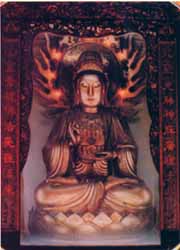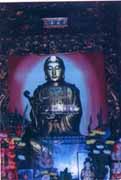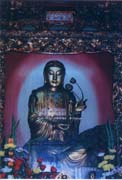| Guanyin |
|
|
|
Lungshan
Temple is dedicated to Guanyin. Known in Sanskrit as Avalokitesvara,
Guanyin is the subject of more popular Chinese legends than any other
deity. We hear lots of stories about Guanyin from the time we are kids.In World War II Lungshan Temple took a direct hit in an Allied
air raid and much of the main hall was destroyed, but the statue of
Guanyin came out of it unscathed. Now if that¡¦s not a miracle, how
else do you explain it?! |
|
According
to popular legend, Guanyin was originally named Miaoshan, the daughter of King Miaozhuang. After Miaoshan had grown, King Miaozhuang
ordered her to marry, but the princess refused so that the
angry king ordered the nuns to have Miaoshan do all the most difficult
chores. Eventually, however,
spirits started doing these chores for her. When the king found out, he
had the monastery set ablaze. All the monks and nuns met their death in
the fire, but Princess Miaoshan came out unscathed. The king ordered her
beheaded, but the axe broke in three pieces upon her neck.The
king ordered her hung, but the rope broke. Just as the princess fell to
the ground, dark clouds filled the sky and a tiger bounded forward to
Miaoshan¡¦s side. She rode off on the tiger¡¦s back, taking a servant
with her. . The Immortal of the West, Taibaixing, turned
himself into an old man and led Miaoshan to the Fragrant Hills, where
she endured hardships for several years to cultivate her personal
virtue. One day, word arrived that her father had fallen gravely ill, so
Miaoshan returned to the royal palace, where she gouged out her eyes and
cut off an arm to restore her father¡¦s health. Ever since that time
she has spent her days doing good deeds and saving countless multitudes. |
|
| Boddhisatva Wenshu | |
|
|
To
the left of Guanyin¡¦s statue in the main hall at Lungshan Temple is a
statue of the boddhisatva Wenshu (Sanskrit: Manjusri). Wenshu is the
left-hand attendant of Sakyamuni Buddha. He is said to have appeared and
expounded Buddhist teachings on Mount Wutaishan in Shanxi Province,
which remains today a place of pilgrimage for Chinese Buddhists who wish
to pay him homage |
| Boddhisatva Puxian | |
|
|
On
Guanyin¡¦s right is the boddhisatva Puxian (Sanskrit: Samantabhadra).
Just as Wenshu is always on Guanyin¡¦s left, Puxian is always on the
right. His statue looks rather similar to that of Wenshu. He represents
the practice and meditation of all the buddhas, while Wenshu represents
wisdom and realization. Guanyin, Wenshu, and Puxian make up a trinity.
They are also among the four greatest boddhisatvas of Buddhism, together
with Dizang (Kshitigarbha). Puxian is generally represented riding on a
six-tusked white elephant, and he represents the great compassion of
Buddhist doctrine. |


